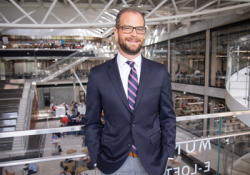The University of Texas professor Seth Bank is involved in two new multi-university million dollar multi-disciplinary projects from the National Science Foundation aimed at fostering collaboration in quantum information and computation research. The foundation of both projects is a new class of artificial semiconductor materials developed in Bank’s lab that are engineered at the few atom scale to exhibit electronic and optical properties not found in nature.
One project, led by Prof. Bank, is to develop a new class of photodetector that is capable of counting photons. While photodetectors have been demonstrated that are sensitive enough to detect a single photon, they rarely can discriminate between one photon, two photons, three photons, etc. and often work only at very low temperatures. With colleagues at the University of Virginia, Bank’s team will develop a photodetector capable of photon number resolution at room temperature, which is a critical technology for quantum information processing and quantum computing.
The second project, led by Prof. Juliet Gopinath at the University of Colorado Boulder, is built around the new ability to share information through photonic integrated circuits which encode information on light, rather than electricity. It specifically looks to create a single photonic integrated circuit chip for quantum information processing. Such a chip would allow secure quantum networking and quantum computing, replacing the binary zeros and ones of conventional computing with multivariable quantum bits. This change would allow for much more secure communications and computation than current state-of-the-art. The practical applications include significantly improved data encryption for personal privacy.
CU Boulder Electrical, Computer, and Energy Engineering Associate Professor Juliet Gopinath said the funding for these projects come as part of a new push by the NSF to connect engineers, physicists and material scientists together, leveraging the expertise of researchers deeply invested in quantum science with newcomers, who bring different capabilities to address large problems.
“Part of the push from the NSF is bringing together engineers and physicists to advance the state of quantum science in chip-scale systems that can be mass produced,” Gopinath said. “The project combines expertise in several areas, from materials growth to semiconductor detection to quantum theory.”
The projects, titled “Photon-Number-Resolving Integrated Avalanche Photodiodes for Scalable Quantum Computing” and “On-Chip Entanglement, Preparation, Manipulation, and Detection for Integrated All Quantum Information Processing,” are three-year projects with a budget of $1 million each. The team led by PI Bank includes Co-PIs Andreas Beling, Joe Campbell, and Olivier Pfister from the University of Virginia. The team led by Gopinath at CU-Boulder includes co-PIs Seth Bank from UT, Jonathan Dowling from Louisiana State University, and Joe Campbell from University of Virginia, as well as Amr Helmy from the University of Toronto.
The project at CU will focus on system chip design and integration, with a particular emphasis on the design and characterization of the photonic integrated circuits. Meanwhile, Bank and Campbell have developed a new type of avalanche photodiode with performance rivaling current telecom detectors. These high-sensitivity photodetectors will be enablers. Dowling will work with the experimental characteristics of the chip and develop a protocol.
Gopinath said the project as a whole, was particularly interesting and important because the team would be creating and testing the tools to be used in technology going forward.



